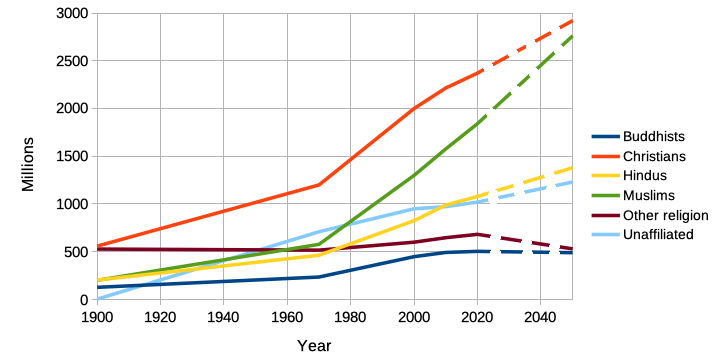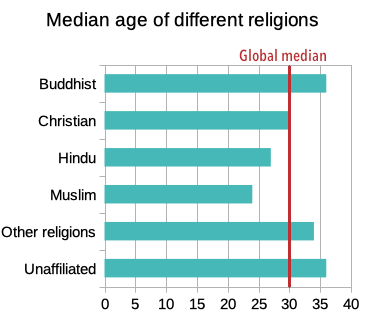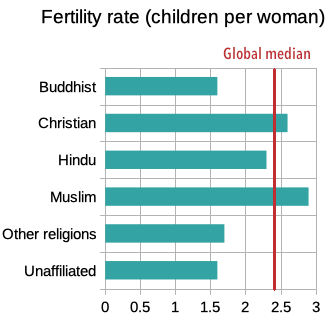
What is the world’s largest religion? Which one is growing the fastest? Is religion in decline? What is the future of religious belief?
These questions are of interest to many people, believers and unbelievers alike. Some answers are easy to guess, some may be a little more surprising.
Here’s the latest information and predictions.
Biggest and fastest growing
Current (2020)
Christianity is still the world’s largest religion, with 32% of the world, followed by Islam (25%), Hinduism (14%) and Buddhism (7%). Other religions currently make up about 9% of the world while “unaffiliated” (non-religious plus religious people who don’t identify with any religion) comprise 14% of the world population.
Islam is growing fastest at almost double the global population growth rate. Hinduism’s growth rate is slightly above the global rate while Christianity’s growth is about the same as the world’s. Buddhism’s growth rate is much lower than the global average and is projected to decline still further. Other religions are also growing very slowly, while unaffiliated are growing at about half the world average
These figures are based on national censuses and other estimates (see Note on data), and so measure cultural identification. Of course the figures don’t recognise whether belief is an important part of a person’s life or not, or even, in some countries, whether people have been able to express their true beliefs. For information on committed belief, see True believers.
Projections to 2050
There is great interest in the future. It is predicted that by 2050, Islam (30% of world) will have almost equalled Christianity (31%), Hinduism will have grown slightly to 15% while Buddhism will have dropped to 5%. Other religions are expected to fall to about 6% by 2050, while it is predicted unaffiliated numbers will have grown slightly, but in percentage terms will have dropped slightly to 13%.
6 factors which influence growth rate
1. Wealth
Wealthier and more stable countries tend to have lower birth rates. Because the unaffiliated and many christians live in the first world, they tend to have lower birth rates.
2. Birth and death rates
- Muslims have a high birth rate and a relatively low mortality rate because of a young population.
- Christians have a high birth rate in much of the world. But in the west they have a lower birth rate and a higher death rate because of an older age profile
- At the other end of the scale, Unaffiliated have a low birth rate and a higher death rate, because they mostly live in countries with older, more wealthy, populations who have less children.
- Buddhists and other religions also tend to have lower birth rates.
3. Age profile

The age profile, often measured by the median age of a population, is both a cause and a result of the birth rate. Younger populations tend to have more women at an age to give birth, and the higher birth rate tends to keep the population young. Only Islam and Hinduism have median ages below the global median, while Christianity is at about the world median (see graph).
4. Number of children per woman

Fertility rates (the number of children born to each woman) obviously also have an effect. Muslim and Christian women have larger families on average than the global average (see graph). Hindus are below the global average but above the replacement level of 2.1 children per woman. The other groups (Buddhists, other religions and Unaffiliated) are below the replacement level and, unless something changes, will be unable to sustain their populations.
5. Religious switching
Religious switching, or conversions occur when a child raised in one religious grouping chooses in later life to change their belief. Switching, of course, can occur both into and out of any belief. Most religions (and many non-religious people too) seek to make converts, but according to the data this is a smaller factor than birthrate.
Islam, the unaffiliated and other religions are all projected to gain numbers through switching, while Christianity and Buddhism are projected to lose numbers. However the net numbers of gains and losses are generally quite small – less than 0.1 million per year.
The only significant switching is the projected net loss of about 1.5 million people per year from Christianity (about a million converts a year, but 2.5 million losses, mainly in Europe and North America), and a similar gain to the unaffiliated. But these changes are still relatively small compared to the demographic changes which are measured in billions.
6. Migration
Migration can make a substantial difference to religious populations in some countries, and can lead to immigrants being exposed to now ideas and religions.
True believers
All of these figures are based on how people identify, not on what they actually believe and how important (or not) their faith is to them. This information is harder to gather, and the information is somewhat conflicting.
The World Values Survey has gathered data on the importance of faith for different religious believers, and found that up until about 2007, religion was growing in importance in 33 of 49 countries studied. However since 2007, religion has declined in importance in 43 out of 49 countries, and only increased in importance in 6. The study suggested that religious belief flourishes when there is decline of economic, physical, and psychological security. Improvement in economies, health and safety have led to a drop in religious belief.
Pew Research has slightly different findings from its surveys of four indicators of religions commitment – affiliation, importance of religion, worship attendance and frequency of prayer – in over a hundred countries. Contrary to the World Values Survey, Pew found that about half the countries, mostly located in Africa, South America and southern Asia, had positive views of the importance of religion. Prayer and worship attendance were slightly lower, but still positive in a significant number of countries. Religion is less important among the younger population in almost every country.
It is hard to know how to interpret these differences so I won’t try. We can just say that not all those who identify with a religion believe it has an important part in their life, and this trend may be greater among younger people.
The future of religion
There used to be an expectation (known as the Secularisation Thesis) that industrialisation, urbanisation, the growth of science and education would lead to a decline in religion. This has happened in Europe, once the centre of Christianity. But the global statistics on religion have led to the thesis being questioned or even rejected.
- Some say there will always be a trend in modern societies for people to leave religion, but this will be more than balanced by the higher birthrate of religious people, and so religions will contiue to grow in numbers.
- Others say that may be the case, but religions will nevertheless diminish in influence, both in people’s lives, and in societies.
- Another view is that it will be social stability and prosperity that lead to the diminishing of religion’s influence.
- It doesn’t seem that atheism is making large inroads into religious belief. If people leave their religion, they seem more likely to become agnostic or spiritual but not identifying with an established religion.
Of course, if there is a God, demographics and statistics won’t be the only factors in determining the future.
A note on data
There is a lot of data on religious identification, and it isn’t all consistent – different surveys use different time periods, or different statistics, and there is often more than one way to estimate religious populations.
I have tried to use the most recent data. Mostly I have used numbers published by Pew Centre and the World Religion Database. For the main graph, where both organisations had different figures for the various populations, I averaged the two.
References
- Pew Forum:
Christians remain world’s largest religious group, but they are declining in Europe, 2017.
The Changing Global Religious Landscape, 2017.
The Global Religious Landscape, 2012 (article).
The Global Religious Landscape, Dec 2012 (full report).
The Future of World Religions: Population Growth Projections, 2010-2050. 2015.
How religious commitment varies by country among people of all ages, 2018. - World Religion Database. Information only available for a fee, but this site is the basis for several other references.
- World Religion Projections. Data Hub. (Based on Pew Research.)
- Religion by Country 2022. World Population Review. (Based on Pew Research.)
- National / Regional Profiles. Association of Religion Data Archives, 2022. (Based on World Religion Database.)
- The World’s Largest Religious Groups Over Time. Statista, 2021. (Based on Pew Research.)
- Growth of Religion. Wikipedia. (Based on World Religion Database.)
- Religion: why faith is becoming more and more popular. Guardian, 2018.
- Religion’s Sudden Decline, Revisited. Ronald Inglehart et al, Center for Political Studies, University of Michigan, 2021. THJis paper updates another paper, Giving Up on God: The Global Decline of Religion, Ronald Inglehart, Foreign Affairs, 2020.
- The future size of religiously affiliated and unaffiliated populations. C Hacket et al, International INstitute for Applied Systems Analysis, 2015.




Is that not a worrying trend for Christians? Islam is in many manners similar to Christian religion, but they belief nonsense about Jesus’s death and also belief God can make moral wrongs right and opposite.
Maybe nonsense is little harsh but what I mean, no historian beliefs that Jesus didn’t die on the cross.
Hi Marta, I guess it is a worrying trend. Maybe not as a demographic trend, but because christians are not winning people over.
Yes, few historians would accept that Jesus didn’t die. Historically it is just about the best attested fact about him. It seems to me that Islam is somewhat similar to Judaism (different beliefs, but similar attitudes to ancient Jews). But Jesus takes us onwards and upwards from both of them. I am less worried about what I think they get wrong than I am that they miss some of the core things that Jesus did and said.
Thanks for your comment.
Thank you for the response. Yes I suppose that’s more central.
I think it is hard to say if Islam is more similar to Judaism, like dietary laws and centrality of law, or Christianity, like seeing Jesus as the Messiah and the prophet from God. On God’s goodness, Christianity seems between Islam and Judaism!
I guess we can make all sorts of comparisons, and all would be valid. My comment was based on thinking that both Islam and Judaism have significant rituals, holy days, dietary requirements, etc, while christianity has moved a little away from those (in its most Jesus-like form – he opposed some of that, preferring loving ethics). That’s a simplification, but I hope not totally in error.